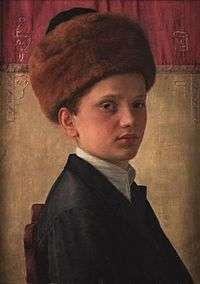Isidor Kaufmann


Isidor Kaufmann (Hungarian: Kaufman(n) Izidor, Hebrew: איזידור קאופמן; March 22, 1853 in Arad – 1921 in Vienna) was an Austro-Hungarian painter of Jewish themes. Having devoted his career to genre painting, he traveled throughout Eastern Europe in search of scenes of Jewish, often Hasidic life.
Life and career
Born to Hungarian Jewish parents in Arad, Kingdom of Hungary (presently in Romania), Kaufmann was originally destined for a commercial career, and could fulfill his wish to become a painter only later in life.
In 1875, he went to the Landes-Zeichenschule in Budapest, where he remained for one year. In 1876, he left for Vienna, but being refused admission to the Academy of Fine Arts there, he became a pupil of the portrait painter Joseph Matthäus Aigner. He then entered the Malerschule of the Vienna Academy, and later became a private pupil of Professor Trenkwald.
His most noted paintings refer to the life of Jews in Poland. They include: Der Besuch des Rabbi (the original of which was owned by Emperor Franz Joseph I, in the Kunsthistorisches Museum), Schachspieler, Der Zweifler (for which he received the gold medal at the Weltausstellung of 1873).
Kaufmann's other honors include: the Baron Königswarter Künstler-Preis, the gold medal of the Emperor of Germany, a gold medal of the International Exhibition at Munich, and a medal of the third class at the Exposition Universelle in Paris.
One of his most prominent students was Lazar Krestin.
References
| Wikimedia Commons has media related to Isidor Kaufmann. |
-
 This article incorporates text from a publication now in the public domain: Isidore Singer, Laura Landau (1901–1906). "Isidor Kaufmann". In Singer, Isidore; et al. Jewish Encyclopedia. New York: Funk & Wagnalls Company.
This article incorporates text from a publication now in the public domain: Isidore Singer, Laura Landau (1901–1906). "Isidor Kaufmann". In Singer, Isidore; et al. Jewish Encyclopedia. New York: Funk & Wagnalls Company. - Alexander Kohut, Berühmte Israelitische Männer und Frauen
- (Romanian) Ileana-Rodica Dinculescu, "Teme în pictura unor artişti evrei din Europa Modernă (până la mişcarea de avangardă)" ("Themes in the Art of Jewish Painters in Modern Europe– Before the Avant-Garde Movement"), at the University of Bucharest site
- Isidor Kaufmann (1853-1921)